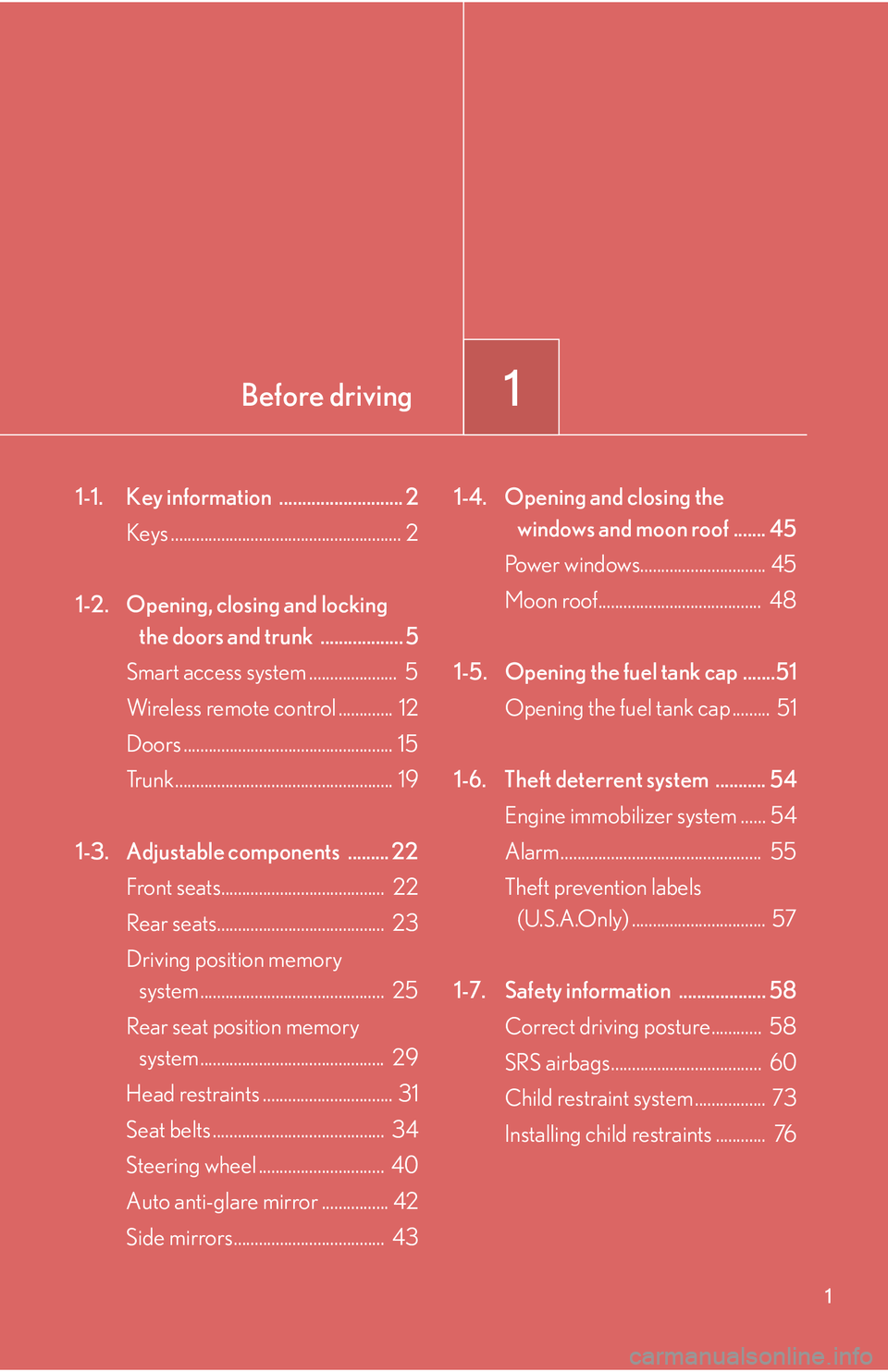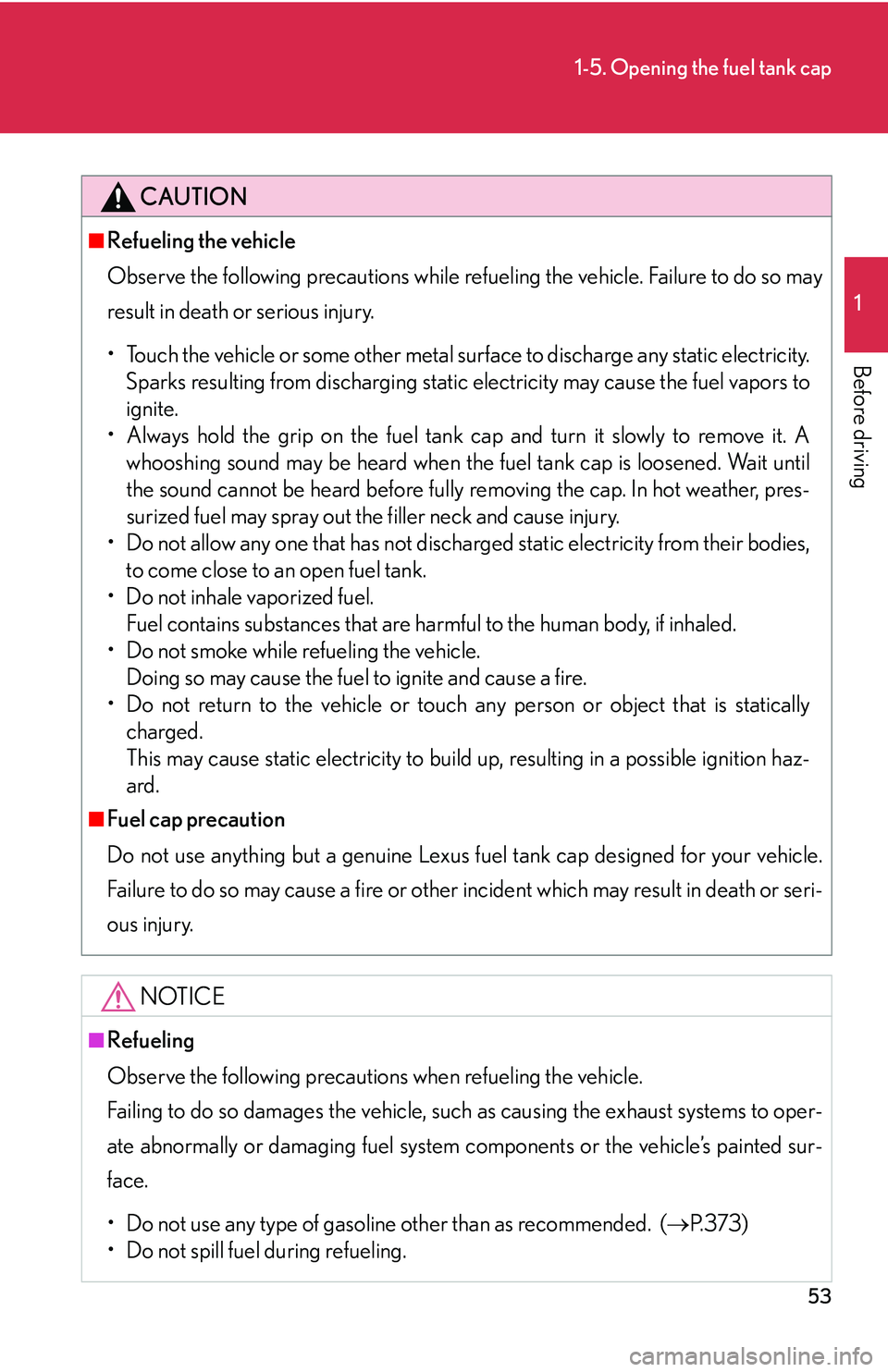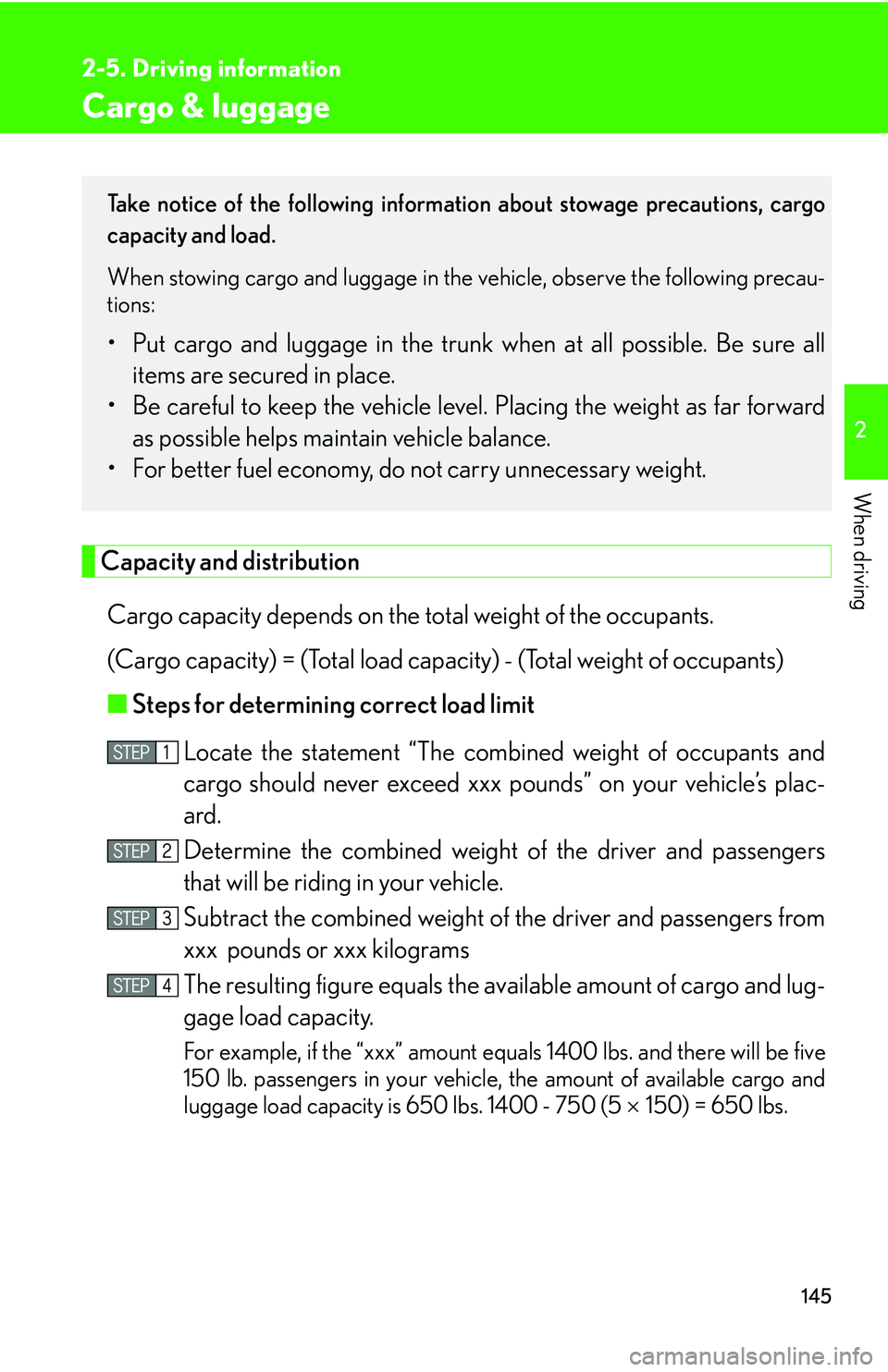2006 LEXUS LS430 fuel cap
[x] Cancel search: fuel capPage 2 of 419

TABLE OF CONTENTSIndex
1-1. Key information .............................. 2Keys ......................................................... 2
1-2. Opening, closing and locking
the doors and trunk ..................... 5
Smart access system......................... 5
Wireless remote control ............... 12
Doors..................................................... 15
Trunk...................................................... 19
1-3. Adjustable components ............ 22 Front seats .......................................... 22
Rear seats ........................................... 23
Driving position memory
system ............................................... 25
Rear seat position memory
system ............................................... 29
Head restraints.................................. 31
Seat belts ............................................ 34
Steering wheel.................................. 40
Auto anti-glare mirror................... 42
Side mirrors ....................................... 43
1-4. Opening and closing the
windows and moon roof .......... 45
Power windows................................ 45
Moon roof .......................................... 48 1-5. Opening the fuel tank cap ......... 51
Opening the fuel tank cap............ 51
1-6. Theft deterrent system............... 54 Engine immobilizer system ......... 54
Alarm.................................................... 55
Theft prevention labels
(U.S.A.Only) .................................. 57
1-7. Safety information ...................... 58 Correct driving posture .............. 58
SRS airbags ....................................... 60
Child restraint system
................... 73
Installing child restraints ............... 76
2-1. Driving procedures..................... 86 Driving the vehicle .......................... 86
Starting the engine ......................... 94
Automatic transmission................ 98
Turn signal lever.............................. 101
Parking brake ................................. 102
2-2. Instrument cluster ..................... 103 Gauges and meters ..................... 103
Indicators and warning lights ... 105
Multi-information display........... 107
1Before driving
2When driving
Page 17 of 419

1Before driving
1
1-1. Key information ........................... 2Keys ....................................................... 2
1-2. Opening, closing and locking
the doors and trunk .................. 5
Smart access system ..................... 5
Wireless remote control ............. 12
Doors .................................................. 15
Trunk.................................................... 19
1-3. Adjustable components ......... 22 Front seats....................................... 22
Rear seats........................................ 23
Driving position memory
system ............................................ 25
Rear seat position memory
system ............................................ 29
Head restraints ............................... 31
Seat belts ......................................... 34
Steering wheel .............................. 40
Auto anti-glare mirror ................ 42
Side mirrors.................................... 43 1-4. Opening and closing the
windows and moon roof
....... 45
Power windows.............................. 45
Moon roof....................................... 48
1-5. Opening the fuel tank cap .......51 Opening the fuel tank cap ......... 51
1-6. Theft deterrent system ........... 54 Engine immobilizer system ...... 54
Alarm................................................ 55
Theft prevention labels
(U.S.A.Only) ................................ 57
1-7. Safety information ................... 58 Correct driving posture............ 58
SRS airbags.................................... 60
Child restraint system ................. 73
Installing child r
estraints ............ 76
Page 67 of 419

51
1
Before driving
1-5. Opening the fuel tank cap
Opening the fuel tank cap
Perform the following steps to open the fuel tank cap.
■Before refueling the vehicle
Stop the engine and ensure that all the doors and windows are closed.
■ Opening the fuel tank cap
Lift the fuel filler door opener to
open the fuel filler door
.
Turn the fuel tank cap slowly to
ope
n.
Hang the fuel tank cap on the back
of the fuel filler door
.
Page 68 of 419

52
1-5. Opening the fuel tank cap
Closing the fuel tank cap
When replacing the fuel tank cap,
turn it until a clicking sound is
heard.
■Fuel types
Use premium unleaded gasoline (91
Octane rating or higher) (P.373).
■Fuel tank capacity
The fuel tank has a capacity of approximately 22.2 gal. (84 L, 18.5 lmp.gal.).
■In case the fuel filler door does not function
This is used in case the fuel filler door cannot
be opened due to a discharged battery or
other trouble.
Page 69 of 419

53
1-5. Opening the fuel tank cap
1
Before driving
CAUTION
■Refueling the vehicle
Observe the following precautions while refueling the vehicle. Failure to do so may
r
esult in death or serious injury.
• Touch the vehicle or some other metal surf ace to dischar
ge any static electricity.
Sparks resulting from discharging static electricity may cause the fuel vapors to
ignite.
• Always hold the grip on the fuel tank cap and turn it slowly to remove it. A whooshin
g sound may be heard when the fu el tank cap is loosened. Wait until
the sound cannot be heard before fully removing the cap. In hot weather, pres -
surized fuel may spray out the filler neck and cause injury.
• Do not allow any one that has not discharge
d static electricity from their bodies,
to come close to an open fuel tank.
• Do not inhale vaporized fuel.
Fuel contains substances that are harmful to the human body, if inhaled.
• Do not smoke while refueling the vehicle.
Doing so may cause the fuel to ignite and cause a fire.
• Do not return to the vehicle or touch an y perso
n or object that is statically
charged.
This may cause static electricity to build up, resulting in a possible ignition haz -
ard.
■Fuel cap precaution
Do not use anything but a genuine Lexus fuel tank cap designed for your vehicle.
F
ailure to do so may cause a fire or other incident which may result in death or seri -
ous injury.
NOTICE
■Refueling
Observe the following precautions when refueling the vehicle.
Failing to do so damages the vehicle, su ch
as causing the exhaust systems to oper -
ate abnormally or damaging fuel system c
omponents or the vehicle’s painted sur-
face.
• Do not use any type of gasoline other than as recommended. ( P.373 )
• Do not spill fuel during refueling.
Page 161 of 419

145
2
When driving
2-5. Driving information
Cargo & luggage
Capacity and distribution
Cargo capacity depends on the total weight of the occupants.
(Cargo capacity) = (Total load capacity) - (T
otal weight of occupants)
■ Steps for determining corr
ect load limit
Locate the statement “The combin ed w
eight of occupants and
cargo should never exceed xxx pounds” on your vehicle’s plac -
ard.
Determine the combined weight of the driv
er and passengers
that will be riding in your vehicle.
Subtract the combined weight of the driver and passengers from
xxx pounds or xxx kilograms
The resulting figure equals the available amount of car
go and lug-
gage load capacity.
For example, if the “xxx” amount equa ls 1400 lbs. and there will be five
150 lb. passengers in your vehicle, the amount of available cargo and
luggage load capacity is 650 lbs. 1400 - 750 (5 150) = 650 lbs.
Take notice of the following information about stowage precautions, cargo
capacity and load.
When stowing cargo and luggage in the vehicle, observe the following precau-
tions:
• Put cargo and luggage in the trunk wh en at all possible. Be sure all
items are secured in place.
• Be careful to keep the vehicle level. Placing the w
eight as far forward
as possible helps maintain vehicle balance.
• For better fuel economy, do not carry unnecessary weight.
Page 271 of 419

255
4-2. Maintenance
4
Maintenance and care
Emission inspection and maintenance (I/M) programs
Some states have vehicle emission in spection programs which include OBD
(On-Board Diagnostics) checks.
The OBD system monitors the operation of the emission control system.
■ If the malfunction indicator lamp comes on
The OBD system determines that a pr
oblem exists somewhere in the
emission control system. Your vehicle may not pass the I/M test and
may need to be repaired. Contact your Lexus dealer to service the
vehicle.
■ Y
our vehicle may not pass the I/M test:
●When the battery is disconnected or discharged
Readiness codes that are set during or
dinary driving are erased.
Also, depending on your driving habits, the readiness codes may not
be completely set.
●When the fuel tank cap is loose
The malfunction indicator lamp co mes on as tempor
ary malfunction
and your vehicle may not pass the I/M test.
■ When the malfunction indicator lamp goes off after se
veral driving
trips
The error code in the OBD system wi ll not be clear
ed unless the vehi-
cle is driven 40 or more times.
■ If y
our vehicle does not pass the I/M test
Contact your Lexus dealer to prep ar
e the vehicle for re-testing.
Page 280 of 419

264
4-3. Do-it-yourself maintenance
■Adding the engine oil
If the oil level is below or near the low
level mark, add engine oil of the same
type as already in the engine.
Make sure to check the oil type and prepare the items needed before adding.
Remove the oil filler cap.
Add engine oil slowly, checking the dipstick.
Return the filler cap and turn the ca
p clockwise until you hear a
click.
It takes about 1.6 qt. (1.5 L, 1.3 lmp.qt.) to raise the oil level from low to full on the
dipstick.
■ Recommended viscosity
Temperature range anticipated before next oil change.
SAE 5W-30 is the best choice for
goo
d fuel economy, and good starting
in cold weather.
If SAE 5W-30 is not available, SAE
1
0W-30 may be used. However, it
should be replaced with 5W-30 at
the next oil change.
Dummy
Oil gradeILSAC multigrade engine oil.
ItemsClean funnel (only for adding oil)